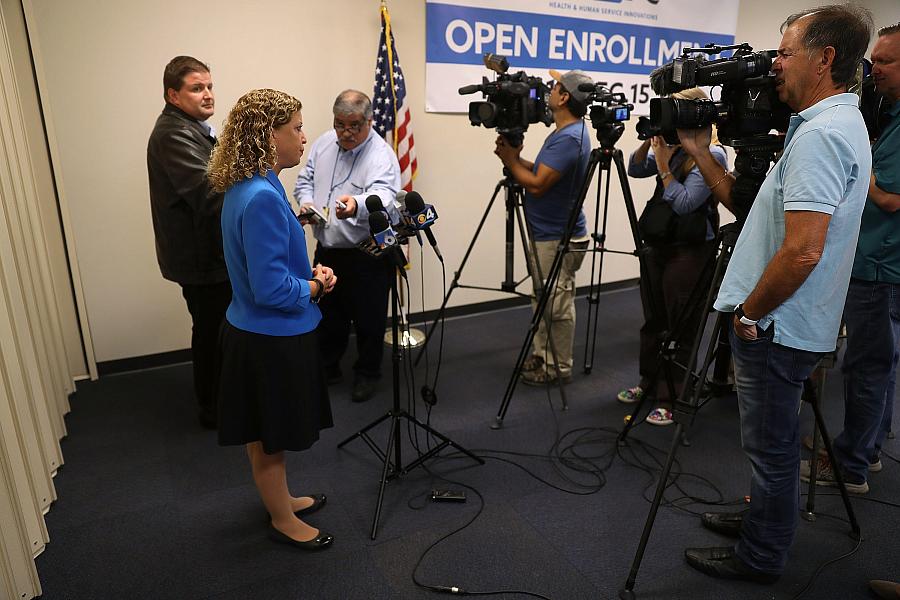As Trump guts ACA’s ad budget, a tour of the evidence on how advertising affects insurance sign-ups

Rep. Debbie Wasserman Schultz (D-FL) talks to reporters Tuesday at a press conference about the Affordable Care Act in Hollywood, Florida. The deadline to sign up was Jan. 31, 2018 but the Trump administration has cut it back to Dec. 15, 2017. (Photo by Joe Raedle/Getty Images)
By Erika Franklin Fowler and Sarah Gollust
On November 1, open enrollment for the marketplaces created by the Affordable Care Act (ACA) will begin, but this year will be much different than the prior four. Specifically, the 2018 open enrollment period will have a much shorter enrollment window — only 45 days compared to three months last year — and a dramatically reduced budget for advertising, outreach and enrollment assistance. How is that likely to matter?
Low awareness of open enrollment, high confusion
The first thing to know is that public awareness of the insurance marketplace is low. A Commonwealth Survey from earlier this year reported that nearly 40 percent of the uninsured were unaware of the marketplaces, while a Kaiser Family Foundation survey conducted this month reported that only 15 percent of the uninsured knew when the open enrollment period starts and even fewer (5 percent) knew when it ends. That same survey also reported that 63 percent of the uninsured did not know the amount of the fine they would pay if they didn’t have health insurance in 2018. Further, with all of the news coverage surrounding attempts to repeal and replace the ACA, there is both confusion and politically polarized views among the public about whether the ACA marketplaces are collapsing and whether there are insurance plans available. In addition, only 22 percent of Americans were aware that concerns about the ACA marketplaces only affect those who purchase insurance on their own, not those who have insurance through their employers.
In light of the low levels of awareness and high levels of confusion, advertising can play a crucial role in both informing the public and encouraging the uninsured to sign-up for health insurance. Through a series of studies examining the influence of Affordable Care Act television advertising using Kantar/CMAG data available to us through the Wesleyan Media Project, we found that more advertising correlates with increased perceptions of feeling informed, increased information-seeking behavior and larger reductions in uninsurance rates.
Advertising and perceptions of information
In the first study, we combined October 2013 public opinion data available from the Kaiser Family Foundation with the amount of ACA-related advertising (and local television news content) airing in the respondent’s media market to assess how exposure to media messaging may correlate with perceptions about the law. Our results revealed that exposure to health insurance advertising correlated with increased perceptions of “having enough information about the health reform law to understand how it will impact you and your family.” More specifically, the probability that an individual reported having enough information rose from 30 percent at low levels of exposure to health insurance advertising to 70 percent at high levels of exposure.
Less advertising, fewer online visitors
In another study, we used the case of Kentucky, where the new governor who took over in 2015 failed to renew the advertising contract for Kynect, the state’s insurance marketplace, cancelling all advertising with only six weeks left in the 2016 open enrollment period. This rare shift in advertising volume gave us analytical leverage with which to assess how advertising relates to information-seeking. We used data from the state of Kentucky on page views, website visits, unique visitors and phone calls. More specifically, our analysis suggested that the without an advertising campaign at all in Kentucky, there would have been 450,000 fewer page views, 20,000 fewer website visits, and 20,000 fewer visitors (and no change in phone calls to the call center).
Advertising boosts insurance enrollment
In addition, we have also used county-level data from the Census Bureau’s American Community Survey to assess the relationships between advertising during the first open enrollment period and county-level changes in health insurance enrollment between 2013 and 2014. Our results (published in Health Affairs) suggested that counties with higher levels of insurance advertising also had greater gains in health insurance, with state-sponsored advertising having the strongest relationship (driven by increases in Medicaid).
The takeaway
Taken together, this evidence suggests that advertising matters. And our work is not the only evidence out there: a report entitled “Marketing Matters,” examining Covered California, suggests that marketing has a better than three-to-one return on investment in higher insurance take-up. Extrapolating to the current policy environment, our research suggests that the dramatic cuts to the Health and Human Services outreach may lead to reductions in people feeling informed about their options and enrolling in health insurance.
Of course, third parties, including state-based marketplaces, advocacy groups and journalists themselves play an important role in reminding consumers about the open enrollment period and better informing the public (especially the uninsured) about the options available and how to sign-up. What is clear, however, is that without third parties stepping up to increase outreach, the drastic cuts to advertising are important, and the cuts could reduce enrollment and weaken the insurance pool, potentially leading to even more unstable health insurance markets in the future.
Erika Franklin Fowler is an associate professor of government at Wesleyan University and co-director of the Wesleyan Media Project. Sarah E. Gollust is an associate professor of health policy and management at the University of Minnesota.

